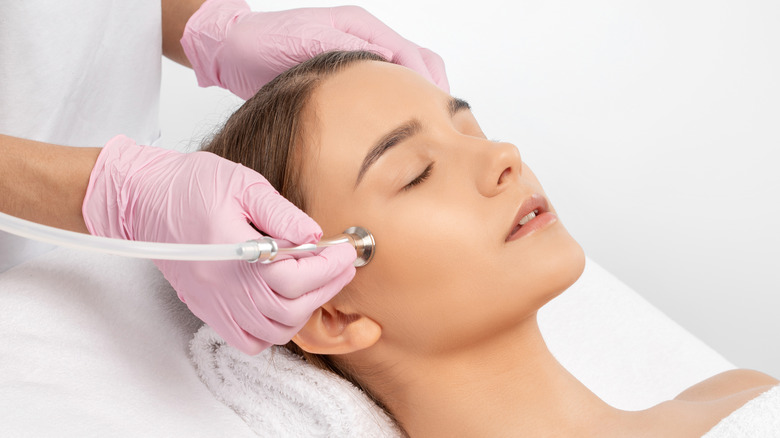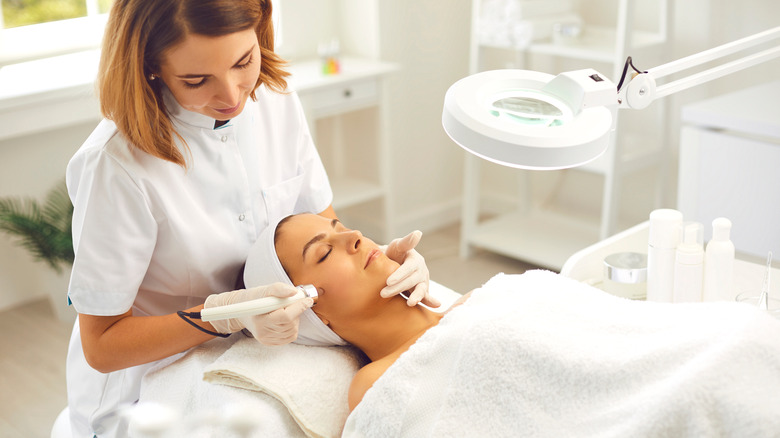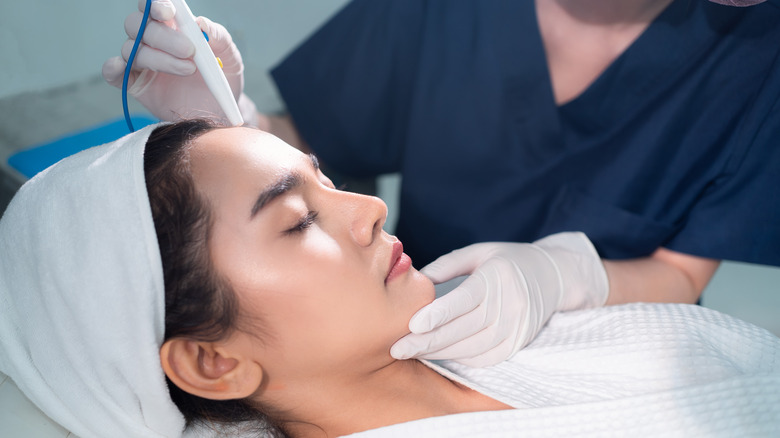Microdermabrasion: What To Know About The Potential Downsides
Any skincare lover will know that getting facial treatments are part of getting healthy skin. Depending on your skin type, specific treatments could be a much-needed reset for your face. In recent years, skin treatments have grown because of the numerous benefits and the people who swear by them. While the success of any treatment will depend on how your skin reacts to the treatments and the goals you had going in, there's no denying that they've made quite the impression on many. One of the breakout stars of skincare treatments is microdermabrasion. This treatment is considered a standard for skincare and seems to be a service everywhere nowadays. While you need a licensed professional to conduct microdermabrasion, the premise is simple. During this treatment, you are essentially scraping the dead skin off of your face. The goal is to reveal smoother skin that will give you a healthy glow.
Although many fans turn to it every few weeks, many aren't sure if it's the solution to their skin troubles. Many believe that a proper skincare routine could solve some of the issues microdermabrasion promises to solve. No matter your opinion on microdermabrasion, you can't deny it has affected how we look at skincare treatments. However, like any procedure, it's essential to examine the potential downsides of a treatment that has gone as viral as the way this one has.
Is it worth it?
While microdermabrasion treatments will immediately give you the appearance of healthy, glowy skin, they come at a price. The American Society of Plastic Surgeons explains that the average cost of a microdermabrasion treatment is around $167 for each session. To get consistent and long-lasting results, you'll need to continue to go back and receive multiple treatments every few weeks. The average cost will rise depending on the additional treatments you add to your session. While facial treatments are undoubtedly a great way of giving your skin a much-needed reset, they aren't always accessible to everyone. Based on the results, it's not a treatment necessary for achieving or maintaining healthy skin.
While many claim that microdermabrasion is a great way to repair the skin for various skin issues, the truth is that it will only fix superficial problems. Microdermabrasion can repair areas of mild hyperpigmentation and scarring. However, it won't improve the skin's elasticity or issues beneath the surface. If you have only mild surface-level skin issues, microdermabrasion will remove or reduce their appearance. However, you could solve these issues with potent ingredients in your skincare routine, like retinol or retinoid products. The price of a microdermabrasion treatment is far above that of building your skincare routine, complete with an exfoliating step. Although it may instantly make your skin look clear, it can unnecessarily waste your money.
Does it actually work?
As we now know, microdermabrasion is an excellent treatment if you're looking to fix superficial issues like fine lines or small wrinkles. However, if you're looking to slow down the appearance of aging on your skin, this treatment will simply not do the trick. Active Beat explains that while it can remove these surface problems, you won't receive any long-term solution with microdermabrasion. To be able to see any significant change to your skin, you'll need to continue the treatment for several sessions, and depending on your skin type, that may not be enough to target the problems you want to fix.
Besides the fact this treatment may not deliver any long-term results, microdermabrasion can be dangerous to your skin. Those with dry or sensitive skin should try other facial treatments because microdermabrasion can be aggressive on the skin. Since this type of treatment depends on manual exfoliation, it can be damaging to your skin and require you to use an extensive amount of sunscreen and moisturizer after your treatment. Depending on your skin type, a microdermabrasion treatment could cause your skin to react negatively. Instead of heading to a spa or dermatologist for microdermabrasion, add an exfoliating step to your routine with a soft exfoliant product formulated for sensitive skin.


